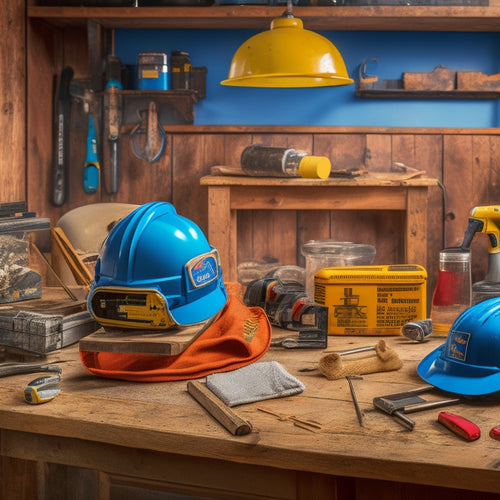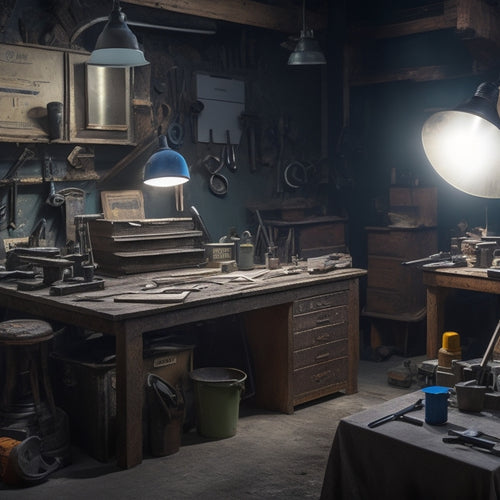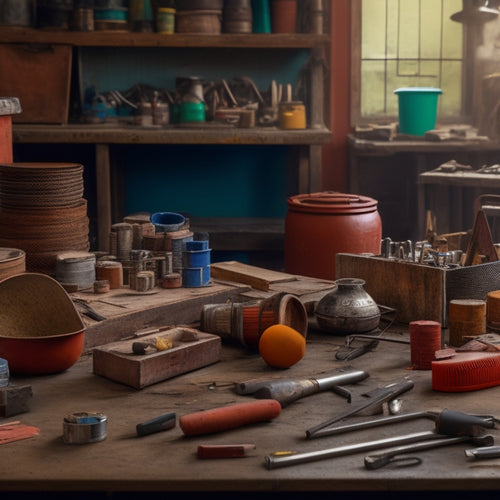
Why You Need These Tools for a Smooth Renovation
Share
You're about to commence a renovation project that requires more than just a vision - it demands the right tools to turn that vision into a smooth, polished reality. Without the essential concrete finishing tools, edging and jointing equipment, and tampering and compacting tools, you'll be left with uneven surfaces, weak joints, and a costly rework. You need quality finishing materials, precise cutting and drilling tools, and safety gear to protect yourself from harm. By understanding the importance of each tool, you'll be well on your way to a stunning renovation that stands the test of time - and it starts right here.
Key Takeaways
• Having the right tools ensures a smooth renovation by preventing costly rework and reducing the risk of mistakes.
• Quality tools help achieve professional-looking results, enhancing the aesthetic appeal and durability of the concrete.
• The right equipment selection prevents uneven edges, joints, and surfaces, saving time and effort in the long run.
• Proper tools enable precise control over concrete finishing, allowing for customization and creativity in design.
• Investing in the necessary tools and equipment ensures a safe working environment, reducing the risk of accidents and injuries.
Essential Concrete Finishing Tools
When finishing concrete, you'll need a range of specialized tools to achieve a smooth, even surface, including trowels, floats, and edgers that are designed to work in tandem to produce a professional-looking finish. These essential tools will help you achieve the desired concrete surface textures, whether it's a sleek, modern look or a more rustic, textured finish.
For decorative concrete finishes, such as stamped or stained concrete, you'll need to invest in additional tools, like stamping mats and acid etching solutions.
To get the best results, it's vital to choose the right tools for the job. A good quality trowel, for instance, will help you achieve a smooth, even surface, while a float will allow you to remove excess water and create a more even finish.
Edgers, on the other hand, are perfect for creating clean, defined edges and corners. By investing in the right tools and mastering the techniques, you'll be able to achieve a wide range of decorative concrete finishes that will elevate your renovation project to the next level.
Edging and Jointing Equipment Needs
When it comes to edging and jointing, you'll want to guarantee you're working with the right equipment to achieve professional-looking results.
Clean edges and well-controlled joints are essential to the overall appearance of your finished concrete surface.
Clean Edges Matter
You'll need the right edging and jointing equipment to guarantee clean edges, which are vital for a renovation that looks professional and lasts.
Clean edges not only enhance the aesthetic appeal of your project but also assure a strong and durable bond between materials. To achieve this, you'll need to master clean edge techniques, such as cutting, grinding, and polishing.
With the right tools, you can choose from various edge treatment options to suit your project's specific needs. For instance, you can opt for a polished edge for a sleek, high-gloss finish or a rough-cut edge for a more rustic look.
When selecting edging and jointing equipment, consider the type of material you're working with, the desired edge finish, and the level of precision required.
Don't compromise on quality, as subpar tools can lead to uneven edges, material damage, and costly rework.
By investing in the right equipment and developing your clean edge techniques, you'll be able to create professional-looking results that will make your renovation stand out.
Joint Quality Control
Two critical aspects of joint quality control are edging and jointing equipment, which demand careful consideration to guarantee strong, durable bonds and a professional finish.
You'll need to invest in the right tools to ensure your joints are properly prepared and finished. This includes edging equipment, such as grinders and polishers, to create precise edges and joints that fit together seamlessly. Jointing equipment, like joint cutters and joint sanders, helps to clean and prepare joints for filling and sealing.
To take your joint quality control to the next level, you should also develop effective joint inspection techniques. This involves regularly inspecting your joints for signs of wear, damage, or deterioration. By catching issues early, you can prevent costly repairs and ensure your renovation stays on track.
Additionally, establishing joint maintenance practices, such as regular cleaning and sealing, will help extend the life of your joints and prevent future problems.
Tamping and Compacting Tools Required
When you're preparing a site for renovation, you'll need to guarantee the soil is compacted to prevent settling or shifting.
You'll have to choose the right soil compaction method for your project, considering factors like soil type and moisture levels.
Next, you'll select the tamping tool that best fits your needs, whether it's a manual or powered option.
Soil Compaction Methods
Before laying the foundation or installing pavers, compacting the soil is vital to prevent settling or shifting. That's where tamping and compacting tools come into play.
You'll need to achieve ideal soil density, which is significant for a stable and even surface. To do this, you'll require a range of compaction techniques.
One method is to use a manual tamper, which is perfect for small areas or tight spaces. This tool helps to remove air pockets and increase soil density.
For larger areas, you can use a plate compactor or a roller compactor, which apply pressure to the soil, making sure it's compacted evenly. These machines are especially useful for preparing the ground for heavy construction or paving.
Additionally, you can use a hand tamper or a jumping jack compactor for more precise control. Regardless of the technique you choose, it's important to compact the soil in layers, allowing each layer to settle before adding more material.
Tamping Tool Options
Your tamping tool arsenal should include a mix of manual and mechanical options to tackle various soil types and project scales. This guarantees you're equipped to handle different tamping techniques and materials, from dense clay to loose gravel.
Here are the essential tamping tools to take into account:
-
Hand tampers: Perfect for smaller projects, hand tampers are lightweight, affordable, and easy to maneuver in tight spaces.
-
Plate compactors: Ideal for larger areas, plate compactors use a heavy plate to compress soil, making them efficient for bigger projects.
-
Jumping jack compactors: These mechanical compactors use a piston to deliver powerful, repetitive blows, making them suitable for dense or rocky soil.
-
Roller compactors: With their rotating drum, roller compactors are great for large, flat areas like driveways or parking lots.
-
Tamping rakes: A manual tamping rake is a versatile tool that allows for more control over soil density and can be used in conjunction with other tamping tools.
Finishing and Smoothing Essentials
You'll need a range of finishing and smoothing essentials to achieve a professional-looking result, including sandpaper, joint compound, and a putty knife. These tools will help you master various smoothing techniques, ensuring a flawless finish.
Sandpaper, for instance, is perfect for removing imperfections and rough spots, while joint compound is ideal for filling gaps and holes. A putty knife will help you apply and smooth out the compound.
When it comes to finishing materials, you'll want to invest in high-quality products that will enhance the overall look of your renovation. From drywall compound to spackling paste, these materials will help you achieve a seamless finish.
Don't forget to add a dust mask and safety goggles to your arsenal, as you'll be working with fine particles and potential airborne debris.
Concrete Cutting and Drilling Tools
With concrete cutting and drilling tools, you're equipped to tackle the toughest renovation tasks, from demolishing old concrete to making precise holes for pipes and fixtures.
These tools are essential for any renovation project that involves concrete, and having the right ones will save you time, effort, and frustration.
Here are the concrete cutting and drilling tools you need to get the job done:
-
Concrete saws: for cutting through concrete slabs, sidewalks, and walls with ease and precision.
-
Core drills: for making accurate holes for pipes, vents, and other fixtures without damaging the surrounding concrete.
-
Demolition hammers: for breaking up and removing old concrete quickly and safely.
-
Concrete grinders: for smoothing out rough surfaces and removing old coatings.
-
Drill bits and blades: for drilling precise holes and making clean cuts in concrete.
With these tools in your arsenal, you'll be able to tackle even the most challenging concrete-related renovation tasks with confidence and precision.
Safety Gear for Concrete Work
Protecting yourself from the hazards of concrete work is essential, as the dust, debris, and heavy equipment involved can pose serious risks to your health and safety. You need to take proactive measures to guarantee you're well-protected before starting any concrete project.
First and foremost, invest in a good pair of protective eyewear. Concrete dust and debris can easily get in your eyes, causing irritation, scratches, or even blindness. Look for goggles or safety glasses with a snug fit, anti-fog coating, and impact-resistant lenses.
Don't forget about hearing protection, either. The loud noises from concrete cutting and drilling can cause permanent hearing damage or tinnitus. Opt for earplugs or earmuffs that can reduce noise levels by at least 20 decibels. Make sure they fit comfortably and provide a secure seal around your ears.
Measuring and Leveling Tools Needed
Now that you've got the necessary safety gear in place, it's time to focus on the precision tools that'll help you confirm accurate measurements and a level foundation for your concrete project. Measuring techniques and leveling accuracy are vital to getting it right, and the right tools will make all the difference.
Here are the essential measuring and leveling tools you'll need:
-
A high-quality tape measure that can withstand rough handling and provide precise readings
-
A laser level that guarantees perfect horizontal and vertical alignment
-
A spirit level that helps you detect even the slightest deviations from level
-
A set of calipers for taking precise measurements of small objects or tight spaces
-
A digital inclinometer that measures angles and slopes with ease
With these tools in your arsenal, you'll be able to achieve the precision and accuracy required for a successful concrete project. You'll be able to take accurate measurements, confirm leveling accuracy, and avoid costly mistakes that can set your project back.
Curing and Sealing Tool Requirements
You'll need the right curing and sealing tools to guarantee your concrete project achieves ideal strength, durability, and appearance.
Curing methods involve applying a layer to the concrete surface to prevent moisture loss, promoting strength development and reducing shrinkage. You'll require a range of tools, including sprayers, brushes, and rollers, to apply curing compounds effectively. For best results, invest in a high-quality curing spray or liquid membrane-forming compounds.
Sealing techniques, on the other hand, involve applying a protective layer to the concrete surface to prevent damage from environmental factors and enhance its appearance. You'll need specialized tools, such as sealant applicators, squeegees, and rollers, to guarantee a smooth, even application.
Don't forget to choose the right sealant for your project, considering factors like UV resistance, chemical resistance, and slip resistance. By investing in the right curing and sealing tools, you'll be able to achieve a professional-looking finish that will last for years to come.
Miscellaneous Tools for Concrete Finishing
Beyond curing and sealing, concrete finishing requires a range of miscellaneous tools to achieve a flawless, high-quality finish. You'll need these tools to refine your mixing techniques and create the desired surface textures. Here are some essential miscellaneous tools to have in your arsenal:
-
Tamping tools: These are used to compress and flatten freshly poured concrete, ensuring an even surface.
-
Edgers: These tools help create clean, defined edges and joints in your concrete surface.
-
Floats: Used to smooth out the concrete surface, floats come in various sizes and types, including bull floats and fresno trowels.
-
Trowels: These are used for applying and finishing concrete, and come in different shapes and sizes for specific tasks.
-
Jointing tools: These are used to create control joints in the concrete, which help control cracking and improve the overall appearance of the finished surface.
With these miscellaneous tools, you'll be well-equipped to achieve a high-quality finish that meets your renovation goals.
Frequently Asked Questions
Can I Use a Hammer Instead of a Tamping Tool for Compacting Concrete?
You're wondering if you can use a hammer instead of a tamping tool for compacting concrete. While it's tempting, don't do it. A hammer can damage the concrete's surface and compromise its structural integrity.
Instead, explore tamping tool alternatives or learn concrete compaction techniques that guarantee a professional finish.
Invest in the right tools to avoid costly mistakes and guarantee your renovation project turns out exactly as you envision it.
How Often Should I Clean and Maintain My Concrete Finishing Tools?
You're tempted to put off cleaning and maintenance until the end of the project, but don't fall into that trap.
Instead, make it a habit to clean your concrete finishing tools daily, and perform thorough maintenance weekly.
Store them properly in a dry place, away from direct sunlight, to prevent rust and damage.
Establishing a maintenance frequency will guarantee your tools remain in top condition, saving you time and frustration in the long run.
Are There Any Eco-Friendly Alternatives to Traditional Concrete Curing Compounds?
You're looking for eco-friendly alternatives to traditional concrete curing compounds. You're in luck! Sustainable curing options are gaining popularity.
Consider natural alternatives like soy-based or plant-based curing compounds, which reduce VOCs and environmental impact. These eco-friendly options can provide similar performance to traditional products.
Research and choose a reputable brand that aligns with your values and project requirements.
Do I Need to Rent a Concrete Mixer or Can I Mix by Hand?
As you're researching eco-friendly alternatives to traditional concrete curing compounds, you're probably wondering if you can mix concrete by hand or need to rent a mixer.
Let's face it, mixing by hand can be a real workout, but it's not the most efficient concrete mixing technique.
Renting a mixer has its advantages, like saving time and energy, and ensuring a consistent mix.
You'll be glad you did, especially for larger projects.
Can I Use a Regular Drill Bit for Drilling Into Concrete?
You're wondering if you can use a regular drill bit for drilling into concrete. Don't even think about it!
Regular drill bits won't cut it (literally). You need specialized drill bit types, like masonry bits or carbide-tipped bits, designed for concrete drilling techniques.
These bits are engineered to withstand the intense friction and heat generated when drilling into concrete. Using the right bit guarantees a smoother, more precise hole and prevents damage to your drill or the concrete.
Conclusion
You've got the vision, now get the tools. A smooth renovation depends on it.
Without the right gear, your concrete project can quickly turn from dream to nightmare. But with the essentials in hand, you'll be unstoppable.
From edging to curing, every step of the process demands the right tools. Don't settle for subpar results – invest in the best.
Your renovation's success hangs in the balance.
Related Posts
-

Top 3 Safety Essentials for DIY Renovations
When tackling a DIY renovation, you'll want to prioritize three essential safety items to protect yourself from poten...
-

What to Inspect When Buying Used Renovation Tools
When buying used renovation tools, you need to scrutinize every detail to avoid costly mistakes. Inspect for rust and...
-

Budget-Friendly Materials for Your Home Renovation Needs
As you initiate your home renovation, you're enthusiastic to find budget-friendly materials that fit your vision with...


